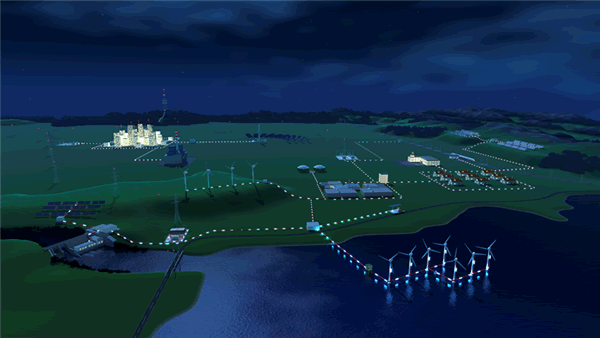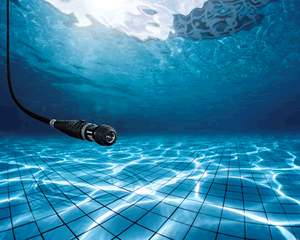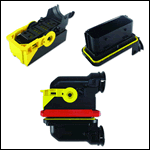The Case for Fiber Optic Cable in Wind Turbines
Fiber optic cable may be the best way to achieve the effective monitoring and control necessary to ensure efficiency in offshore wind turbines.

One of the major challenges facing power generation from renewable energy sources is continuous and cost-effective operation. In the case of wind turbines, both offshore and onshore, this cost-effectiveness depends on several diverse factors, which include their location; the size of the turbines and blades; the standardization of components for production of tower parts, blades, nacelles, and other equipment; as well as ease of maintenance and, most critical, the ability to control the systems as precisely as possible.
A key factor in achieving this operational efficiency is the ability to continuously adjust the turbines to suit the climatic conditions. In order to control the turbine accurately, the nacelle must be continuously changed to suit the wind direction; fine-tuning the rotor blades ensures that they maintain a constant rotation speed in spite of different wind speeds to provide a consistent power supply with constant mains frequency.
To enable this level of control, a large amount of environmental and operating data must be recorded, processed, and returned to the turbine in the form of control commands. One of the best ways to achieve this is with fiber optic cables that can deliver fast, reliable data transfer not just on land but also for offshore wind farms. In particular, fiber optic cables are highly suited to the conditions because they are not sensitive to the powerful magnetic fields which occur in the vicinity of turbines, and they are able to transfer the data from the nacelle to the tower base with almost zero losses.
Fiber Optic Data Cable for Offshore Wind Farms
One example of a project where this will be implemented is a new offshore wind farm currently being built off the coast of England by a global leader in wind turbine manufacture, which has chosen a fiber optic data cable system from HUBER+SUHNER. The system connects the data source and controllable elements in the nacelle to the data cabinet in the tower base. Not only is the system extremely reliable and durable, but it is also very simple and quick to install. Durability and reliability are particularly important for offshore systems since technicians can only access the system by boat or helicopter if maintenance work is required, which incurs additional costs.
The solution consists of time-tested standard components that have been converted into a bespoke plug-and-play system by the developers at HUBER+SUHNER. Therefore, on the rare occasion when maintenance work might be required, only individual components would need to be replaced, rather than the entire system. This is very important in both minimizing maintenance costs and reducing downtimes, which helps to ensure continuous cost-effective energy generation.
China Smart Grid Project
High-specification connector technologies are also in use on the other side of the globe, in the China Smart Grid, to maintain a constant supply of power despite intermittent or irregular output from certain renewable energy sources. At the same time, the ability to manage the efficiency of the power generation plant allows it to react swiftly to fluctuating demands for power consumption and helps meet the geographical challenge of power generation facilities being many hundreds of miles away from the point of power consumption.
The China Smart Grid Project uses a revolutionary multi-fiber outdoor connector from HUBER+SUHNER – the Q-ODC 12. This recently launched new connector is based on the proven QN push-pull mating system. The connector is the same size as the two-fiber Q-ODC but connects up to 12 fibers in one mating step, making it the smallest and most robust design with the highest fiber density in its class. The Q-ODC 12 combines a compact design with MT ferrules and the highest outdoor installation safety for fiber connections.
 The extreme conditions of an offshore wind farm require rugged solutions and the Q-ODC 12 connectors have achieved outstanding results in a series of rigorous industry tests to ensure their durability and performance under extreme outdoor conditions. They are highly waterproof, dust-proof, and corrosion-resistant. In particular, the connectors have survived 30 days’ submersion in more than nine feet of water and have passed extended IP68 waterproof testing. They have also been subjected to stringent vibration testing without suffering any performance loss.
The extreme conditions of an offshore wind farm require rugged solutions and the Q-ODC 12 connectors have achieved outstanding results in a series of rigorous industry tests to ensure their durability and performance under extreme outdoor conditions. They are highly waterproof, dust-proof, and corrosion-resistant. In particular, the connectors have survived 30 days’ submersion in more than nine feet of water and have passed extended IP68 waterproof testing. They have also been subjected to stringent vibration testing without suffering any performance loss.
Offshore wind continues to grow as one of the most important sources of renewable energy, with many new projects being planned and implemented. These projects depend on the range of peripheral technologies that have adapted to the extreme operating conditions around both the wind and the seas. The communications and transmission of data ensure the efficient operation of the turbines, and these are enabled by the properties of fiber optic cables, while the ruggedized assemblies and connectors that have been developed for these environments play a significant part in their success.





